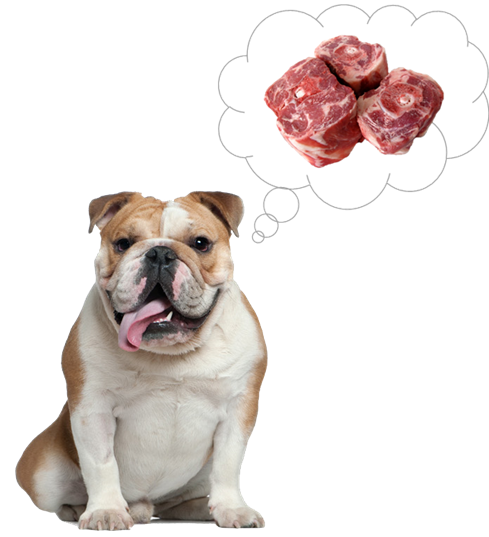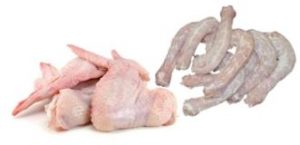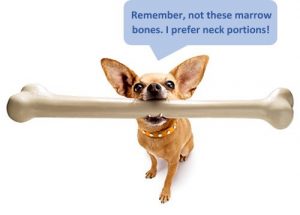Give a Dog a Bone
So, you’ve decided to get your pet’s teeth cleaned (and rotten ones removed) and give him/her a brand new healthy mouth. How do you maintain your pet’s dental health so you don’t need to go through the whole process again? The secret to clean healthy teeth in our pets is actually very simple: RAW MEATY BONES.
It’s no big secret really, just natural healthy food which our pets have eaten throughout evolution. We as humans haven’t domesticated them and made them evolve to eat commercial dog mush nearly long enough to change this process yet. Cats and dogs that regularly eat raw meaty bones (this is the best food we can feed them) are not only healthier animals, but they rarely have rotten teeth at any age.
As veterinarians, we can pick them every time. When a pet has great teeth we ask “He obviously gets plenty of bones?” and the answer is invariably “Yes”. Conversely when we see a patient with very smelly breath and rotting teeth we ask “He doesn’t get much in the way of raw bones does he?” and the answer is invariably “No”.
Cats are particularly difficult to get onto bones if they aren’t started from a very early age, so we recommend them from 6 weeks of age. Dogs just about always love bones and will guard them jealously as they know what’s good for them. Occasionally however some individuals may have a problem with bones – constipation, vomiting, and the very remote possibility of getting one stuck. If bones are cooked, these problems have a higher chance of occurring. We often advise clients, “Yes there is only a very remote chance of getting a serious problem, but the chance of getting a serious problem from infected rotten teeth is a thousand times more. Let alone the poor dog or cat having to live with infected gums, and that smelly breath!” So for our dogs and cats, the positives by far out weigh the negatives.
But what do you do if for one reason or another, you can’t or decide not to use raw bones? Well there are many less effective but still worthwhile alternatives. Number one is Hills’s T/D or “teeth diet”. Despite not being much of a believer in commercial diets, Hill’s is one of the better ones and their T/D is probably the most effective teeth cleaning food next to bones. The dry kibble doesn’t break up until it has sunk to the gum, hence removing the plaque. This diet is especially good for cats. We highly recommend it for any older patients having had their teeth cleaned under general anaesthesia so as to minimise the chance of needing to do it again, if you still decide against the right raw bones.
Then there’s products such as denta bones, raw hide chewies, greenies and the like. All these can help, but these products are commercially lucrative for the companies that make them but not nearly as healthy or as effective as our favourite, you guessed it… RAW. MEATY. BONES.
 So which bones for dogs?
So which bones for dogs?
The following are the bones that best clean the teeth and are least likely to cause any problems:
- Lamb ribs (never feed a single rib, always 3-4 or more whole ribs)*
- Pork ribs (again never one or 2. 3-4 minimum)*
- Lamb neck (portions divided according to size of dog)
- Kangaroo tail portions (our favourite)
*A single rib may be swallowed whole, especially by over exuberant puppies. if this happens you may need to have it surgically removed purely from a physical concern. When you have 3-4 minimum they just eat them calmly.
We often hear some clients say:
“I fed bones but they gave him problems, so I stopped“. We would ask: “Which bones? Have you tried 2 or 3 of the above types of bones specifically? They usually don’t cause problems and also don’t get buried. So until you’ve tried 2-3 of the right raw bones, you still have some options to avoid costly products that often don’t work and costly repeat dental work every few years“.
 So which bones for cats?
So which bones for cats?
- Chicken necks or you can also try wings
What if you have a few dogs that get aggressive with bones, so you can’t feed them?
This is simple: Every morning one dog has his bone outside for 15-30 minutes while the other remains inside. Then the next day….swap! Whatever they have not eaten after 15-30 minutes, throw out. Problem solved. Two healthy dogs for life not needing dental products or costly repeat dental work every 2-3 years.

Can a bone get stuck or cause a problem?
The simple answer is “Yes”, but the likelihood of the right raw bones causing a significant problem is extremely small, but the risk of very poor health and repeat anaesthetic’s in the second half of life are significantly higher. In fact, we are yet to see a dog be in serious trouble from the correct raw bones given 2-3 times weekly, but every vet clinic sees hundreds of dogs every year have poor health from rotten teeth or needing repeat costly dental work every 2-3 years. Hence we ask: “Which risk would you prefer to take?”
So as the old saying goes, give a dog (and a cat!) a bone!
